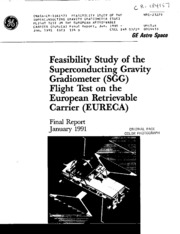
Feasibility study of the Superconducting Gravity Gradiometer (SGG) flight test on the European Retrievable Carrier (EURECA) PDF
Preview Feasibility study of the Superconducting Gravity Gradiometer (SGG) flight test on the European Retrievable Carrier (EURECA)
N91-23229 (NASA-C_-IB41_7) FEASIBILITY STUOY OF THE SUPERCONDUCTING GRAVITY GRAOIOMETER (SGG) FLIGHT TEST ON THE EUROPEAN RETRIEVABLE CARRIER (EURECA) Fina] Report_ Jun. 1990 - Jan. 1991 (GE) 174 p CSCL 14B G3/lq GEAstro Space Feasibility Study of the Superconducting Gravity Gradiometer (SGG) Flight Test on the European Retrievable Carrier (EURECA) Final Report January 1991 ORIGINAL PAGE COLOR PHOTOGRAPH " 2 • MBB @ GE Astro Space 91SDS4201 FEASIBILITY STUDY OF THE SUPERCONDUCTING GRAVITY GRADIOMETER (SGG) FLIGHT TEST ON THE EUROPEAN RETRIEVABLE CARRIER (EURECA) FINAL REPORT CONTRACT NO. NAS 8-38138 Prepared for George C. Marshall Space Flight Center National Aeronautics and Space Administration Marshall Space Flight Center, AL 35812 January 1991 Prepared by GENERAL ELECTRIC COMPANY Astro-Space Division TP3261/A941Cov _-F.J ACKNOWLEDGEMENTS The SGG Flight Test on the EURECA GE/MBB-ERNO Study Team wishes to thank the following individuals and groups for their assistance and contributions to the work summarized in this report: NASA--MSFC Les Johnson Study Manager Dr. Samuel H. Morgan SGGM Study Team Manager Carmine E. De Sanctis Chief, Space Science and Applications Group Brian Barnett Mission Operations University of Maryland Dr. Ho Jung Paik SGG Principal Investigator Dr. M.V. Moody SGG Instrument Development Dr. E.R. Canavan SGG Instrument Development SGGM Study Team (includes persons listed above) Dr. David Sonnabend Jet Propulsion Laboratory Mr. Seymour Kant Goddard Space Flight Center Lt. Col. Gerry Shaw Air Force Geophysics Laboratory TABLE OF CONTENTS Section Page 1 SUMMARY AND INTRODUCTION 1-1 1.1 Summary 1-1 1.2 Introduction 1-2 2 STUDY OBJECTIVES, SCHEDULING AND TECHNICAL APPROACH SUMMARY 2-1 2-1 2.1 Study Objectives 2.2 Schedule 2-1 2-2 2.3 Technical Approach Summary 3 SUPERCONDUCTING GRAVITY GRADIOMETER INSTRUMENT 3-1 3.1 Three-Axis Superconducting Gravity Gradiometer 3-1 3.2 Six-Axis Superconducting Accelerometer 3-2 3.3 Status of Instrument Development 3-4 4 EURECA SYSTEM OVERVIEW 4-1 5 FLIGHT TEST REQUIREMENTS 5-1 6 ACCOMMODATION STUDIES: CONCEPTS AND TRADE-OFFS 6-1 6.1 Configuration Analysis 6-1 6.2 Mechanical Interface 6-4 6.3 Electrical Power 6-10 6.4 Data Handling 6-10 6.5 Environmental Analysis 6-15 6.6 Operational Analyses, Mission Profile 6-18 7 SPECIAL STUDIES 7-1 7.1 On-Orbit Calibration Techniques 7-1 7.2 EURECA Attitude Control and Microgravity Environment 7-16 7.3 Fuel Tanks and Sloshing 7-24 7.4 Magnetic Torquer Assemblies 7-27 7.5 Magnetic Shielding 7-27 ,IwwII TABLE OF CONTENTS (Cont'd) _c_n Page 8 IMPLEMENTATION PLAN 8-1 8.1 EURECA Ground Turnaround 8-1 8.2 Payload Integration 8-2 8.3 Ground Operations 8-7 8.4 Flight Operation 8-11 9 CONCLUSIONS 9-1 9.1 Accommodations 9-1 9.1.1 Configuration 9-1 9.1.2 Mechanical Interface 9-1 9.1.3 E_ectrical Power 9-1 9.1.4 Data Handling 9-2 9.1.5 Thermal 9-2 9.2 Mission Profile 9-2 9.3 Microgravity Disturbances 9-2 9.4 Calibration 9-3 9.5 Magnetic Shielding 9-3 9.6 Implementation Plan 9-3 10 RECOMMENDATIONS 10-1 10.1 Instrument Calibration 10-1 10.2 Magnetic Torquer Assembly 10-1 10.3 Attitude Control Simulation 10-2 10.4 Inverse Square Law--Shuttle as an Object 10-2 10.5 High and Low Earth Pointing Orbits 10-2 10.6 Verification of Calibration Techniques 10-2 10.7 Data Handling and Tank Slosh 10-2 11 ACRONYMS 11-1 APPENDIX A: INSTRUMENT INTERFACE PROPOSAL (liP) A-1 APPENDIX B: SGG CALIBRATION PROCEDURE B-1 APPENDIX C: ORBITAL DISTURBANCE SIMULATION DATA C-1 ¢_ _J iv LIST OF ILLUSTRATIONS Figure Page 2-1 Feasibility Study of the SGG Flight Test on EURECA Reflight 2-1 3-1 Schematic of a Single-Axis Portion of the Engineering Model of the SGG (Model III) 3-2 3-2 Cross-Sectional View of One of the Six Accelerometers Forming the Three-Axis SGG 3-3 3-3 SGG Instrument Noise Power Spectral Density 3-4 3-4 Six-Axis Superconducting Accelerometer (SSA) Assembly 3-5 3-5 SGG/SSA Instrument Package 3-6 4-1 EURECA Mission 1 Configuration 4-2 4-2 Envelope Available for Payloads 4-4 4-3 EURECA Mission Profile 4-4 4-4 Location of AOCS Components 4-9 6-1 SGG Instrumentation Configuration---Preliminary 6-2 6-2 SGG Instrumentation Configuration--Final 6-3 6-3 SGG Accommodation Options 6-3 6-4 EURECA Sensor Field-of-View Analysis 6-5 6-5 SGG Accommodation--Preferred Option 6-6 6-6 SGG Mechanical Interface_Support Structure 6-6 6-7 SGG Mechanical Interface_lnterface Reactions 6-7 6-8 Limit Load Factors for Equipment/Bracket Design 6-7 6-9 Sinusoidal Test Levels 6-9 6-10 Random Vibration Test Level/EURECA Environment for Protoflight Models 6-9 6-11 Random Vibration Acceptance Level 6-11 6-12 EURECA Ground Stations 6-14 6-13 EURECA Data Handling Capabilities 6-14 6-14 PIA Channel Capacity 6-16 6-15 On-Board Data Storage 6-16 6-16 EURECA Ground Station Contact Periods 6-17 6-17 SGG Thermal Node Model 6-18 6-18 EURECA Mission 1--Propellant Budget Design Case 6-20 6-19 SGG Flight Test Mission Profile_Option 1 6-21 6-20 SGG Flight Test Mission Profile--Option 2 6-21 6-21 SGG Flight Test Mission Profile---Option 3 6-22 6-22 Recommended SGG Flight Test Mission Profile 6-23 V LIST OF ILLUSTRA TIONS (Cont'd) Figure Page 7-1 SGG Calibration Requirements 7-4 7-2 SGG Calibration--Rotary Actuators 7-5 7-3 SGG Calibration--Linear Actuator 7-7 7-4 SGG Calibration--SGG/EURECA Relative Motion 7-7 7-5 SGG Calibration--Actuators Mounted on Dewar 7-8 7-6 SGG Calibration---Actuators on Payload Deck 7-9 7-7 SGG Calibration--Actuators Mounted About CG 7-10 7-8 SGG Calibration--SGG/EURECA Relative Motion 7-10 7-9 Microgravity Assessment--EURECA Microgravity Specification 7-17 7-10 Microgravity Assessment--High Frequency 7-18 7-11 EURECA Vibration Environment--Ground Test Data, Background Environment 7-20 7-12 EURECA Vibration Environment--Ground Test Data, All Subsystems On 7-20 7-13 EURECA Vibration Environment--ACS Active Simulation 7-22 7-14 EURECA Vibration Environment--ACS-Only Jets Active Simulation 7-23 7-15 EURECA Vibration EnvironmentmACS Inactive Simulation 7-23 7-16 EURECAmFluid Motion/Calibration Disturbance Coupling 7-24 7-17 Magnetic Torquer Locations 7-28 8-1 EURECA Turnaround Schedule 8-2 8-2 Carrier Processing in Europe 8-3 8-3 Carrier Processing in USA 8-4 8-4 Payload Integration Schedule 8-5 8-5 Overall System Integration and Test Schedule 8-7 8-6 Ground Operations Schedule in USA--Pre-Mission 8-10 8-7 Ground Operations Schedule in USAgPre-Mission 8-10 8-8 Ground Operations Schedule in USAmPost-Mission 8-11 8-9 EURECA Mission Phase 8-12 8-10 EURECA Mission Phases 8-13 8-11 SGG Functional Objectives 8-14 8-12 SGG Check-Out: Shuttle Cargo Bay 8-15 8-13 SGG Check-Out: EURECA Deployment Phase 8-15 8-14 SGG Flight Test Mission--Sequences 8-16 8-15 Experiment Data Acquisition 8-17 vi
